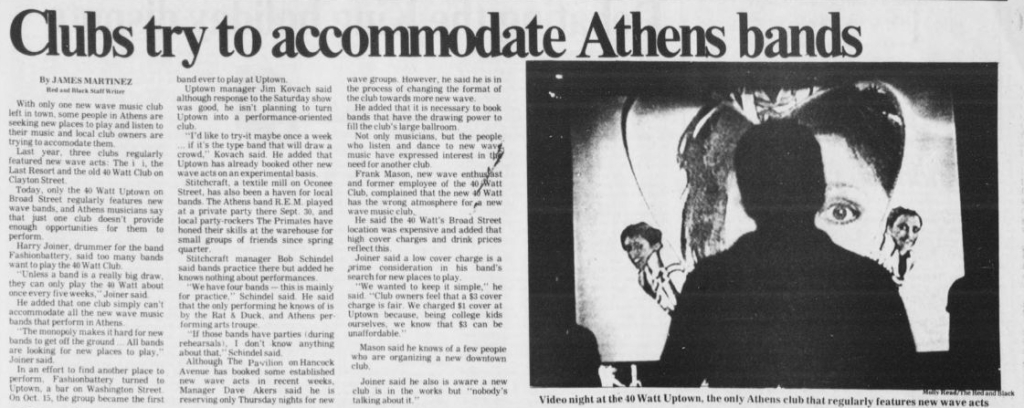Using Newspapers to Track Dates and Locations: The Last Resort and the 40 Watt Club “Uptown”
Part One
Our first article on the B & L Warehouse and Buckhead Beach noted that the 40 Watt Club moved to a new location in 1983, on Broad Street, where a venue called Smoke’s had operated briefly. Though this version of the 40 Watt lasted only four years—in 1987, it returned to its former home on Clayton Street, exactly where the Caledonia Lounge is today—the new, larger location gave the 40 Watt the chance to draw larger audiences and book more bands, helping it become, in the long run, the most recognizable of all Athens live-music venues, indeed almost iconic, as its logo and the very idea of the place has spread across the world.
Another historical development, later in 1983, would need to happen first, however, for the 40 Watt to stake such a central claim in Athens music history: the closure of the Last Resort, the venue that had for the previous decade been the go-to place for new, challenging music and out-of-town acts not popular enough to play the University of Georgia Coliseum or the J & J Center—or the short-lived early version of the Georgia Theatre as a music venue.
The Last Resort, as its name indicates, operated in the same space now held by the restaurant, the Last Resort Grill. It opened at the start of 1967, according to two articles, in January and July, in the Red and Black about the new coffee house/ performance venue. The second of those articles is shown below. Note that the address is 184 West Clayton Street. Originally, it occupied what is now the western side (left, or “stage right,” when facing the building) of the restaurant. By 1976, at the latest, it had expanded, with a separate performance space on the eastern side.
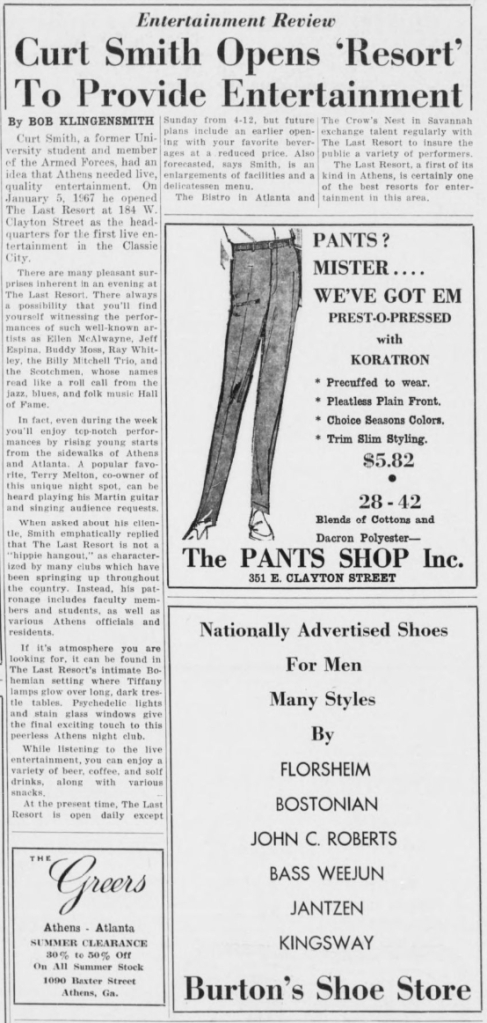
Among the renowned artists who visited the Last Resort in its early years were Odetta, on multiple occasions, David Bromberg in 1972, Dixie Dregs in 1976, and George Thorogood in 1978, not to mention a young, striving Jimmy Buffett in 1973 (at least according to a note about upcoming shows found on page 7 of the October 4, 1973, Red and Black) and a rising comedic star, Steve Martin, in 1976. In 1977, a banner year for the club, Athenians had a chance to see Doc Watson, Tom Waits, and Woody Shaw. A review of the 1973 Odetta concert was written for the January 17, 1973, Red and Black, as seen here.
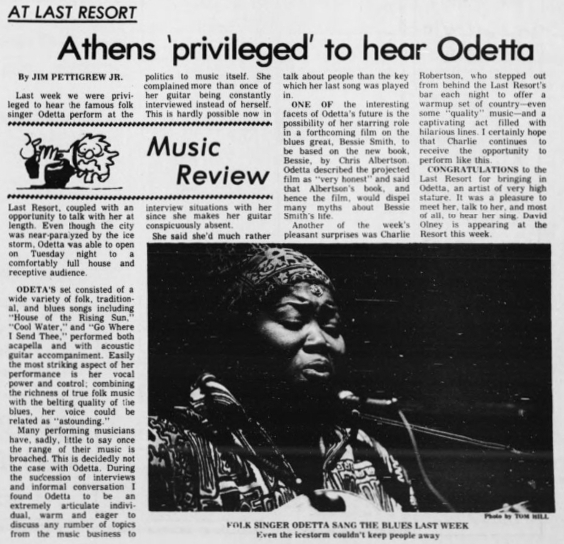
An extensive review of the Tom Waits performance in the November 11, 1977, issue of the Red and Black, shown below, retrospectively shows the artist in a transitional phase of his career. Waits returned to Athens in 1979, playing the Georgia Theatre, as seen in the “After Hours” column and an advertisement from the Red and Black for November 2, 1979 in the second image below.
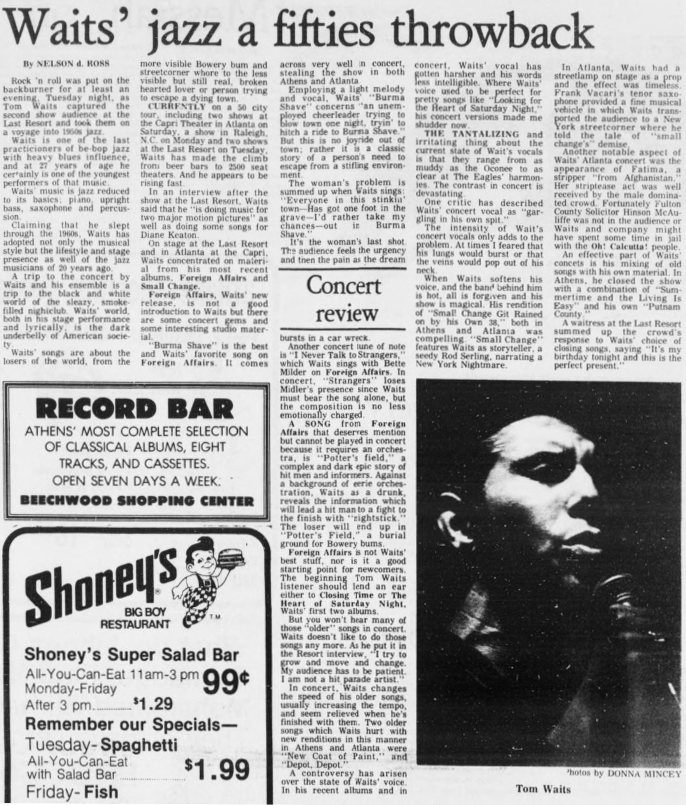
Also of note in this clipping is that the Athens location of the record-store chain, Record Bar, was still at Beechwood. It would later move to the Georgia Square Mall and in turn be replaced by Sam Goody.
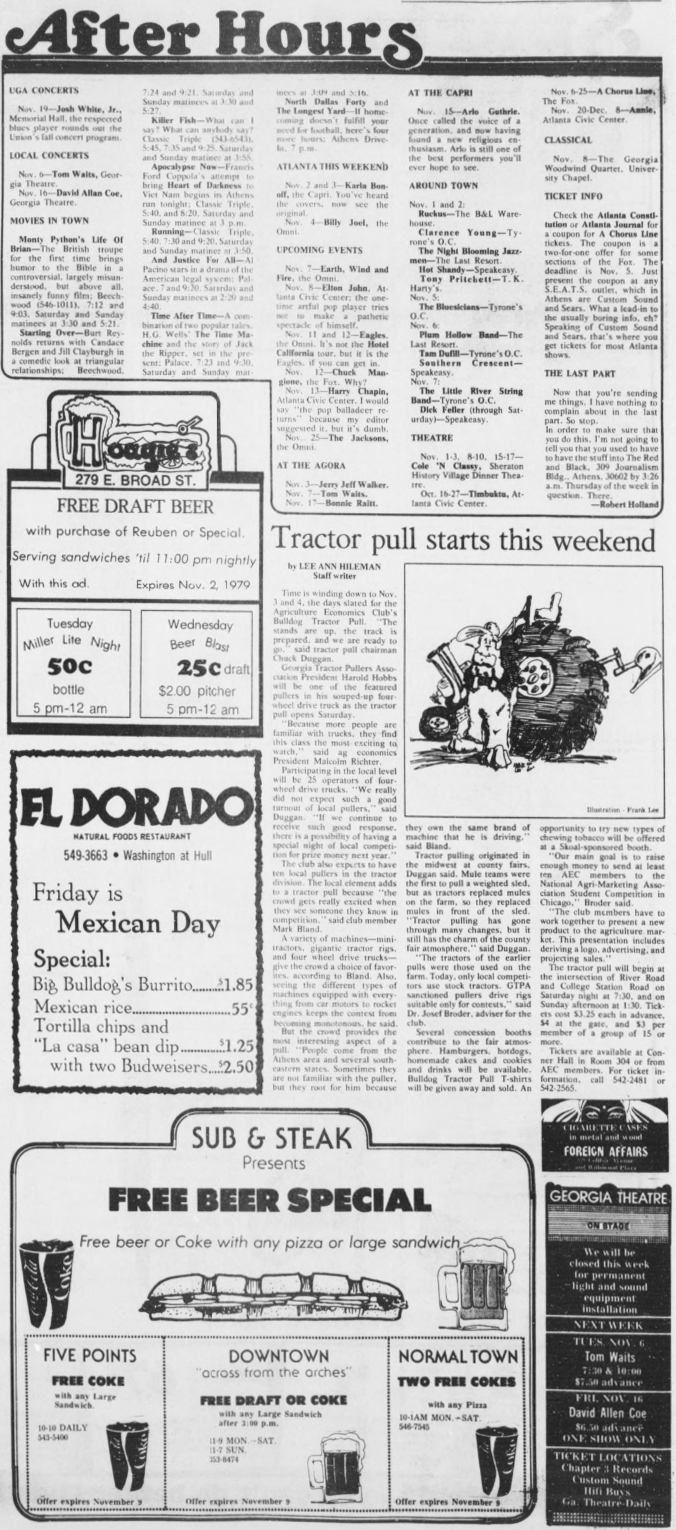
The Georgia Theatre advertisement notes a performance by David Allen Coe, a regular at that venue for much of its history, and lists where one could buy tickets for the venue: Custom Sound (still open today), Hifi Buys (long gone), and Chapter Three Records, a shop on Broad Street that occasionally had performances on its second floor, including no less than the debut of Athens legends Pylon, earlier in 1979.
This page is included in its entirety because of the advertisement for El Dorado, the vegetarian restaurant that later morphed into Bluebird Cafe and was one of several busineses located in the Morton Theatre building before its renovation. And because this edition of the “After Hours” column gives a quick look at what was available in both Athens and Atlanta in November 1979. The Omni and the Atlanta Civic Center were certainly hopping, then, weren’t they?
As we have seen, a diverse array of talent took to the stage at Last Resort, but the venue focused on Folk and Blues. A better example than Odetta or Waits of the kind of lesser-known artists who filled the Last Resort’s schedule is Reverend Pearly Brown, a Blues guitarist from Americus, Georgia, whom you could see perform on the streets of his hometown and later Macon as well as at blues festivals and opening for rock bands. His 1971 performance at the club was advertised in the club’s standard way at the time: against a black background, a simple illustration of a lamp shade, the venue name, and the performer “this week” (Red and Black, October 6, 1971). Brown played both the Last Resort and at various spots on the University campus for multiple visits to Athens, including a night as Bonnie Raitt’s opening act at Legion Field in 1977. That concert was reviewed in the April 19, 1977, issue of the Red and Black.
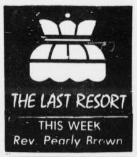
The Last Resort seemed to put on more “big name” artists as the years went by. The number of search results for the Last Resort in the Red and Black increases significantly in the second half of the decade. The following advertisement from the April 20, 1976, issue for the Steve Martin performance shows that the venue was buying more space in the student newspaper.
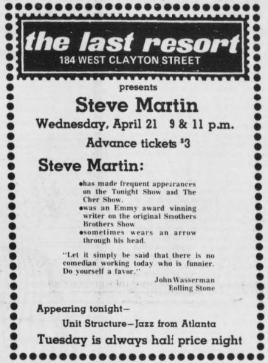
An advertisement from the January 20, 1977, issue of the Red and Black for a performance by the Macon-based group Tall Dogs (which included Joe English, who was briefly a member of Paul McCartney’s Wings) is even bigger. Nonetheless, upcoming performances more characteristic of the club’s original approach, by blues legend John Lee Hooker (based on our research so far, we are not certain this concert ended up taking place) and folk singer Gamble Rogers (a regular at the Last Resort), are also noted.
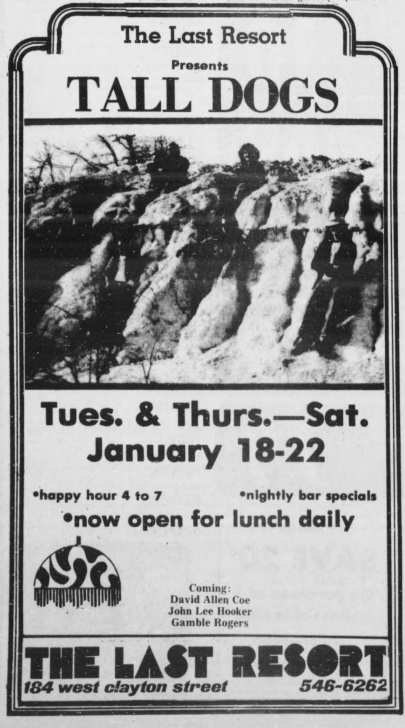
The Last Resort also hosted the young acts of Athens’ “new wave,” as seen in the numerous clippings below of the advertisements the club ran in the Athens Observer, copied from the Heritage Room’s microfilm copies of the weekly newspaper. Even the B-52’s played there, early in the band’s development, as noted in the January 26, 1978, issue of the Red and Black.
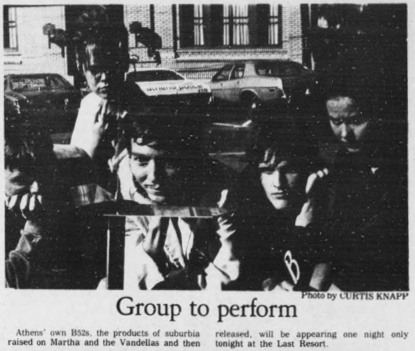
The following clipping from the Athens Observer published on November 4, 1982, offers plenty of treats for Athens historians, with ads for WRFC, Chick Piano, and the Grill (at its original location on Broad Street). Among the performers listed for the Last Resort are two highly-regarded groups associated with the new Athens scene (Guadacanal Diary and Limbo District) as well as an older favorite, Glenn Phillips, who had been a member of Atlanta’s Hampton Grease Band.
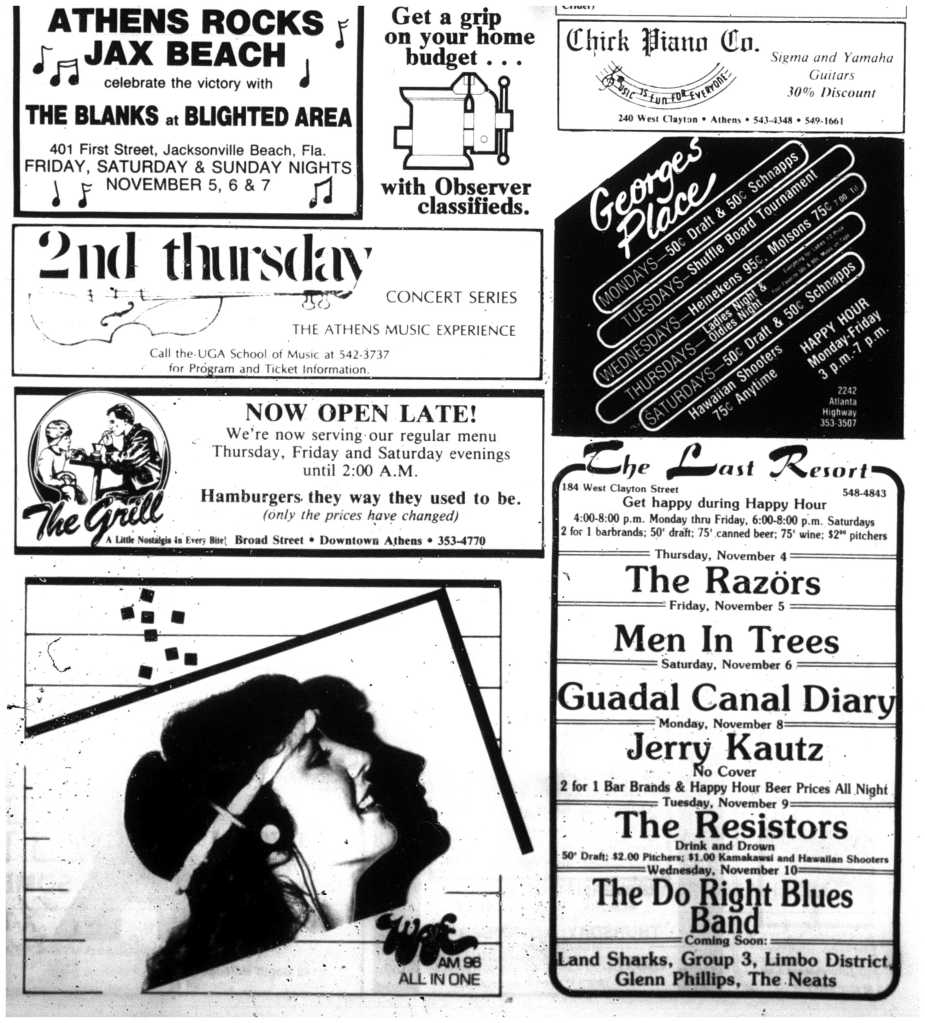
Another clipping from the Athens Observer, December 9, 1982, shows that long-standing local favorites the Normaltown Flyers ventured away from their regular home at Allen’s to play at the Last Resort. The rest of the clipping provides another glimpse of the short history of the “i and i” and part of the Observer‘s events calendar, telling us what was going on at the Armadillo Palace, the 40 Watt, the Lighthouse, the Mad Hatter, Smoke’s, and the Ramada Inn’s Frog Pond Lounge (this hotel later became the Holiday Inn Express, as you can determine from the addressed listed: 513 West Broad Street).
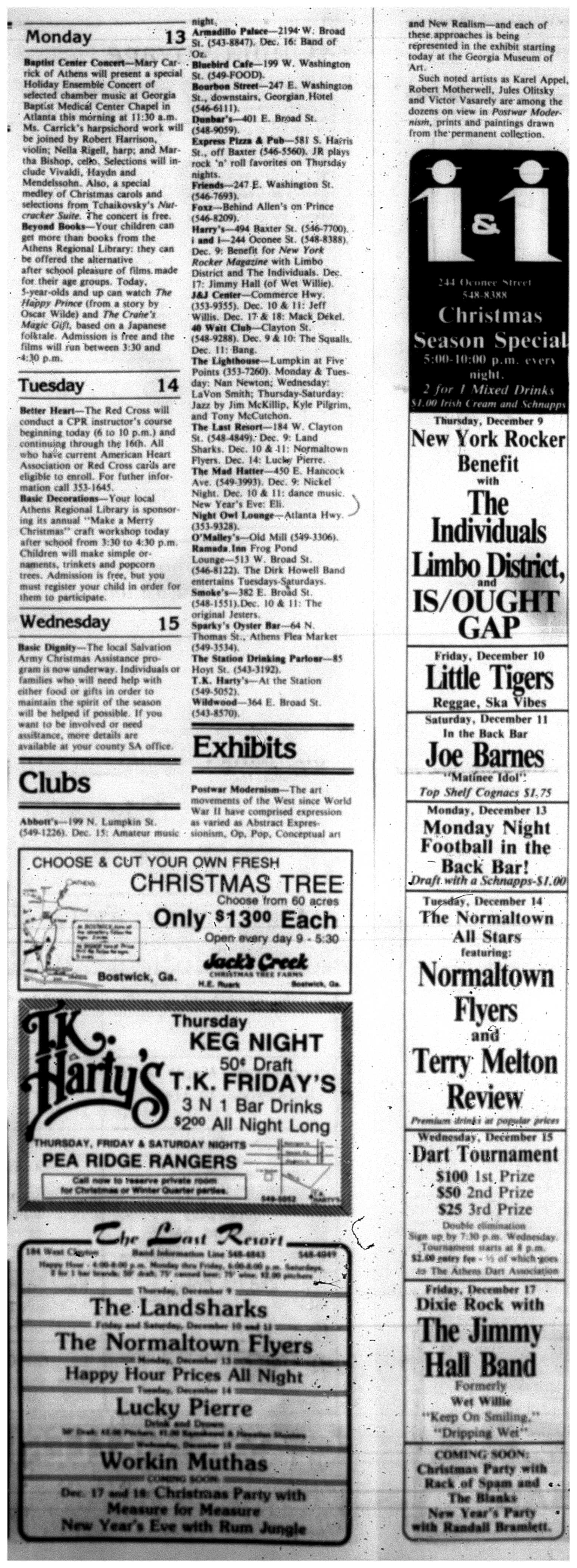
A clipping from the Athens Observer (January 13, 1983) two months later provides an example of the kind of competition that smaller venues, in this case the Mad Hatter and the Last Resort, sometimes faced from the University Coliseum. Deserving of another article itself, the Coliseum hosted many musical greats during this hey day of arena rock. Neil Young, on a rare solo tour promoting his love-it-or-hate-it Trans album, stopped by in early 1983. Look closely and you will see that one could buy tickets (9-10 U.S. dollars for those lowly non-University students!) at Turtle’s, Wuxtry, and Record Bar (now at the mall).
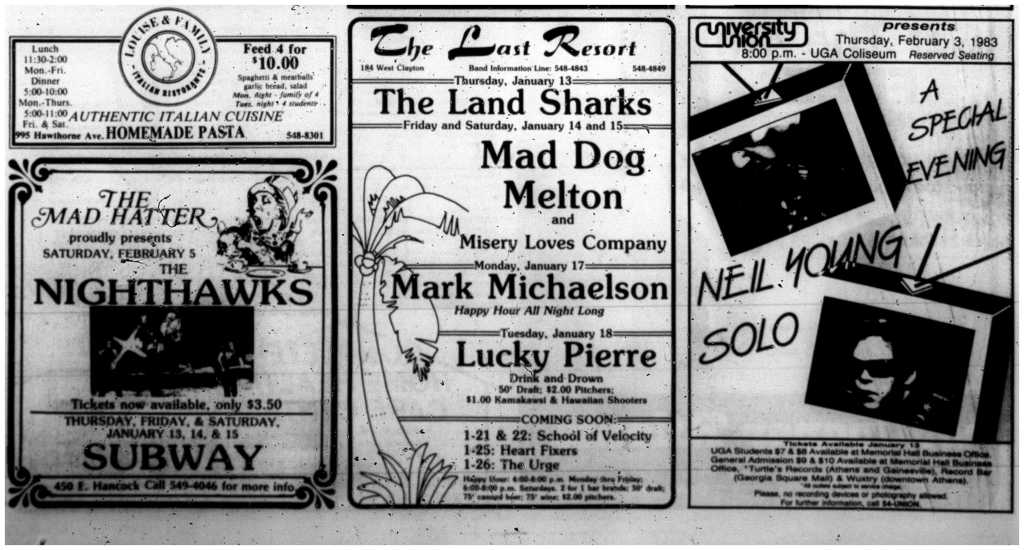
Part Two
At the start of 1983, the Athens music scene that had come under the national spotlight in the previous half-decade seemed fairly stable. The clipping below, found in the Athens Observer for February 24, 1983, gives a sample of what was on offer. The relative small size, and arguably confusing lay-out, of the 40 Watt’s advertisement may suggest where it stood in the nightclub scheme of things: two nascent acts associated with the new music scene, Is/Ought Gap and Oh-OK, visited that spot while Gregg Allman played the Mad Hatter. Allman’s fans would find plenty more music of a similar ilk that weekend: Friday night, the Randall Bramblett Band at Smoke’s, and Saturday night, the Normaltown Flyers at Friends, located in the Georgian building. The Last Resort offered fare perhaps more appealing to the 40 Watt’s regular attendees, especially local band the Squalls and, from Atlanta, Current Rage. Meanwhile, a decidedly different brand of entertainment was taking place at a certain Bourbon Street.
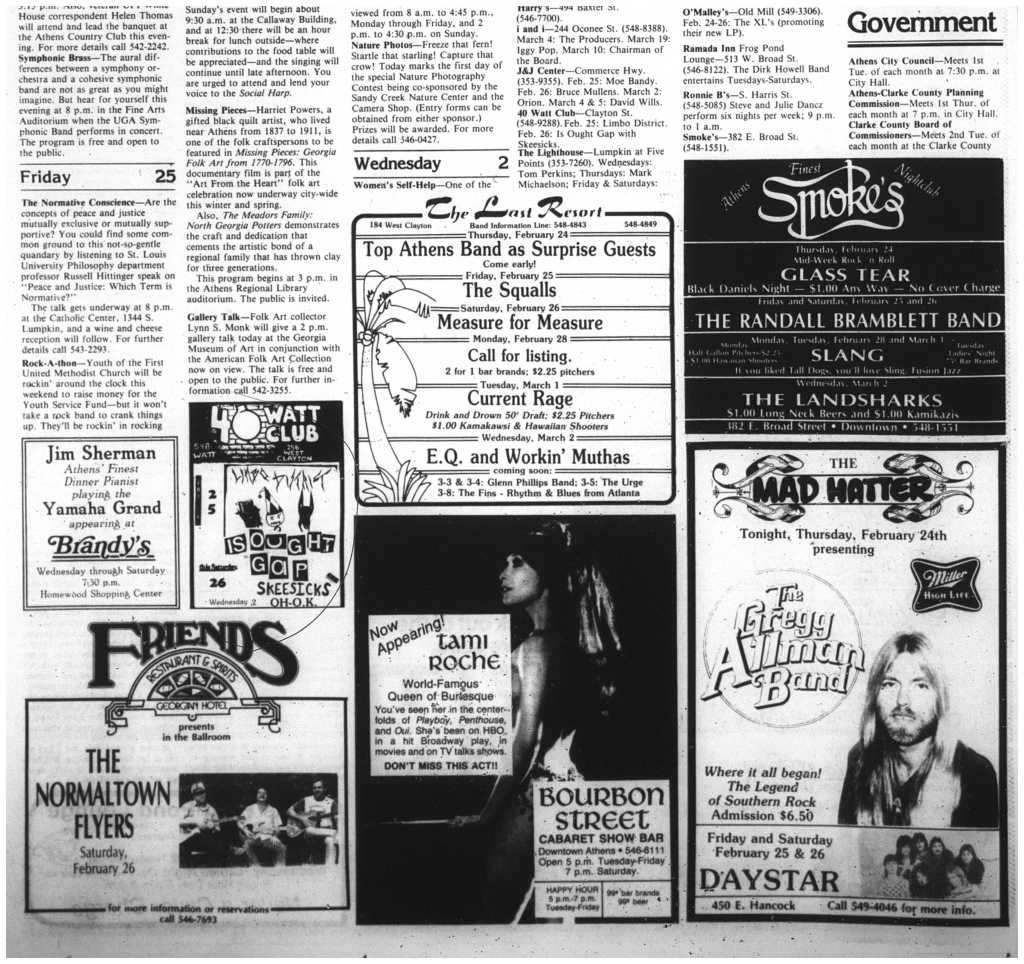
Fast forward to the Athens Observer published on April 7, 1983, and the situation is unchanged: Let’s Active, a group from Winston-Salem, North Carolina, with ties to R.E.M. played the 40 Watt while Tall Dogs set up at Smoke’s. This clipping also provides a taste of what was going at the J & J, out on Commerce Road, and Ronnie B’s, closer to campus.
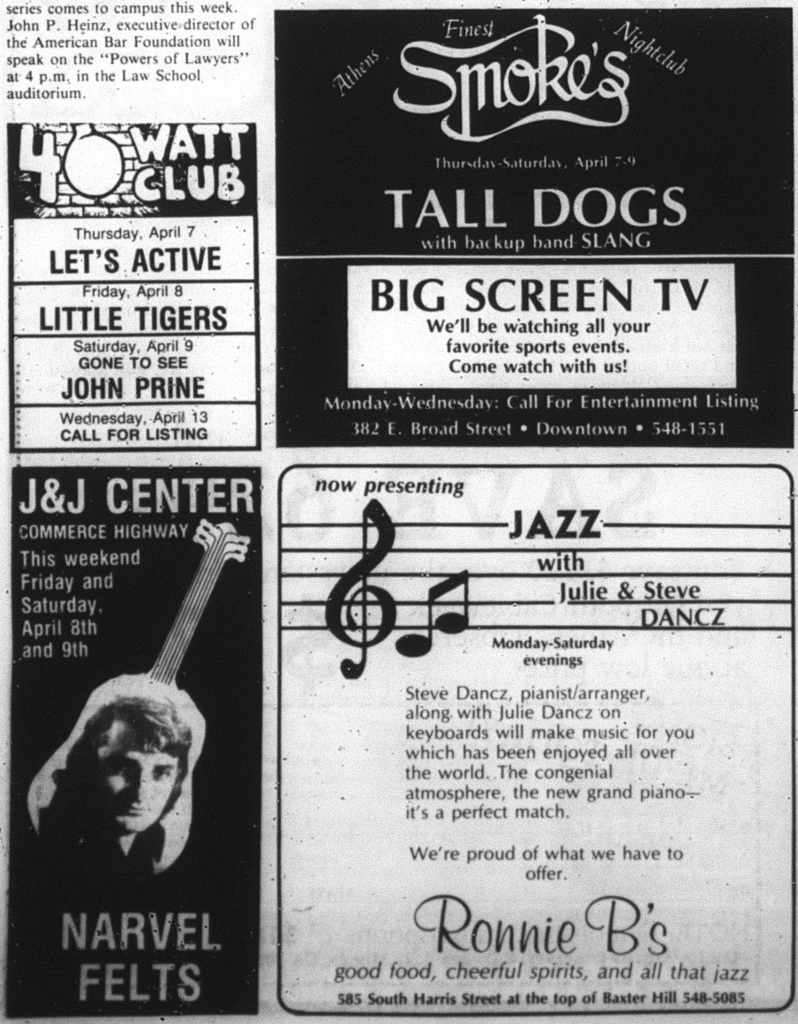
This next clipping from the Athens Observer, April 14, 1983, has been split in two for easier viewing. Notice that Smoke’s appears to be in business, but advertises no live music. Meanwhile, the “i and i” ran into trouble regarding a John Prine show. In the first part of our article on the B & L Warehouse/ Buckhead Beach, a clipping from the Athens Observer mentions this situation as it pertains to the “i and i” closing.

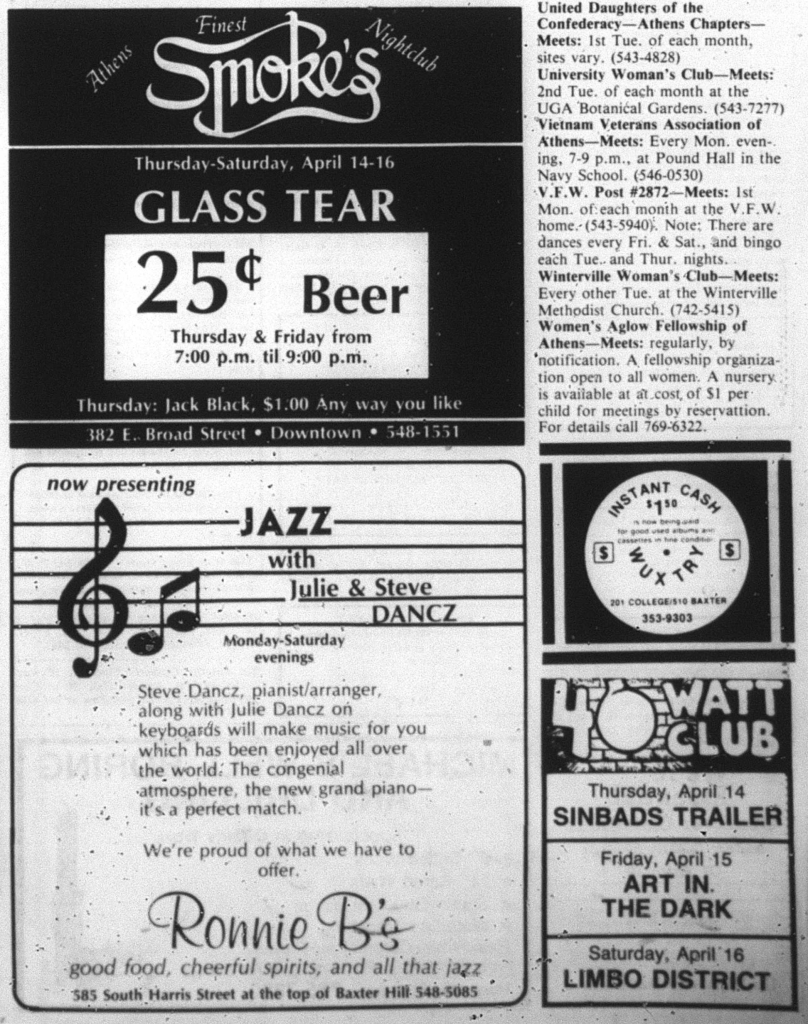
A big change was coming: in the Athens Observer, April 21, 1983, the 40 Watt advertisement announces the arrival of the “Uptown” version of the club, located at 382 East Broad Street. As we can confirm from the clippings above, this was indeed the same address as the now-defunct Smoke’s. This new 40 Watt debuted in fine form, hosting Pylon in what would turn out to be the final year of the first phase of that band’s history (they would return for two more, 1989-1991 and 2004-2009), even announcing an appearance by R.E.M. that, alas, would not happen. At this point in that band’s history, they would switch to playing Legion Field when returning to their hometown. As we have seen in the April 14 Observer clipping above, Pylon had originally scheduled an April 22 gig at the “i and i,” but it had been moved, presumably because of that club’s financial troubles. Or perhaps the new 40 Watt was just a better site for the band’s first gig promoting their second album, Chomp.

The fate of the Last Resort is harder to discern at this point. As suggested previously, the nightclub had started booking more rock bands. The commercial pressures that may have caused this decision certainly had their effect, as the venue temporarily closed in 1978, reopening in February, 1979, under new ownership. An update in the Red and Black, February 9, 1979, seen below, does not go into as much detail as we would like, but at least mentions that the club had undergone extensive renovation.

An indication of how those who had come to enjoy the original version of the Last Resort felt about these changes is provided not by an Athens publication but by the Atlanta Constitution, namely one of its music writers, Bill King. In a November 1, 1980, article in that newspaper, “A New Outlet for the Folk Circuit,” King notes, “the Last Resort’s latest ownership now concentrates on local rock bands.” King, a former resident of Athens, explains that the “folk club” circuit (apparently the term, listening room, was also in favor at that moment) that had been prevalent in the Southeast the previous two decades served as “an alternative acoustic music scene” that grew out of the Folk Revival of the late 1950s-early 1960s. (The “new outlet” noted in the article’s title, by the way, referred to the Speakeasy, a short-lived venue located, like Friends, in the Georgian.)
While acoustic singer-songwriter music would make a comeback roughly a decade after King was writing those words, by 1983 artists like Pylon, Let’s Active, or–an example seen in the 40 Watt ad above–Jason and the Scorchers formed part of a new “indie,” or “college,” rock music. Heralded years later as its own “alternative” to the mainstream, only in retrospect is it easy to see how artists signed to record labels that were “independent” of the mainstream, and who eschewed commercial considerations, were not only a vital part of local scenes like the one found in Athens but were part of a nationwide trend. Before this punk-inspired/ D.I.Y. shift in the listening and socializing habits of American youth, if nightclubs featured live rock music, it was likely to be in the form of artists performing the songs of the top sellers of the day. Most of the bands that you would have heard in the 1970s at the B & L Warehouse, for example, were “the ones who play big high school proms […] and a host of other Top 40 rock and roll cover bands,” as Bobby Byrd described the scene in a Red and Black article from September 19, 1979. In this sense, the Last Resort, in its movement away from folk, blues, and jazz toward rock, actually bridged the gap between two eras of American music as performed at small venues.

Meanwhile, neither the Athens Observer nor the Red and Black noted the closing of the Last Resort, except in passing after the fact. The venue’s advertisements disappeared from the Observer by May, 1983. However, the Last Resort was still to be found in the Athens Banner-Herald/ Athens Daily News Saturday Nightlife listings for June 25, 1983, as seen in the above clipping. Note that the morning and evening papers were still being published separately at this point but were combined on Saturdays. As with the Athens Observer clippings, these come from the Heritage Room’s microfilm collection. The listings are provided in their entirety to give the reader a fuller impression of what was going on in Athens at the time than what can be gleaned from these articles focusing on particular businesses. Unfortunately, this column seems to have only rarely listed performing artists and special events; while some of these spots merely served drinks and served as discos instead of live-music venues, undoubtedly there is a lot of information for the historian to fill in here. At least all of the businesses have their street location noted.

The listing found two weeks later, in the Athens Banner-Herald/ Athens Daily News for July 9, 1983, as seen above no longer includes the Last Resort. Though it may not have been a headline story, undoubtedly the Last Resort’s closure is a landmark in Athens entertainment history, alongside, say, the opening of the Washington Street version of the 40 Watt in 1991 or the fires that devastated Tyrone’s and the Georgia Theatre.
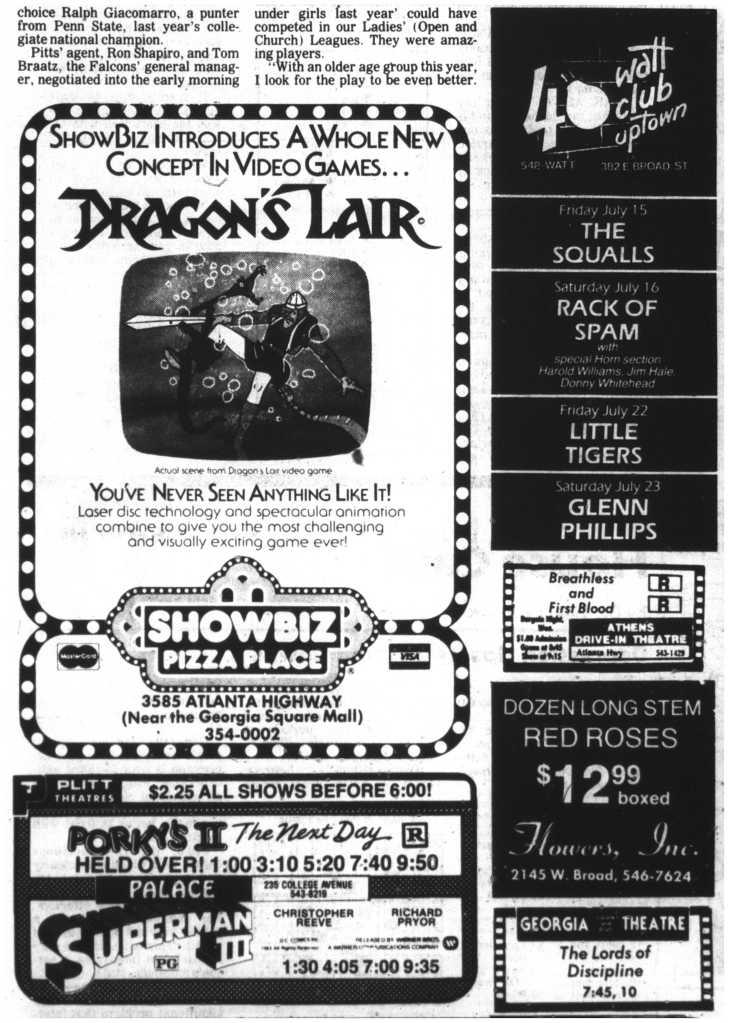
On a lighter note, a clipping from the Athens Banner-Herald/ Athens Daily News, July 15, 1983, shows another 40 Watt ad and lets us know what movies were being screened at the Palace Theatre (part of the Plitt Theatres chain), the Georgia Theatre, and the city’s last drive-in. And we see what new game was being promoted at Showbiz Pizza. Good to know, I suppose, that Porky’s II was attracting crowds in Athens.
We end this installment with a Red and Black article (October 25, 1983) describing the Athens scene toward the end of 1983. Especially noteworthy is the rise of a new hot spot, the Uptown Lounge, located in a building on Washington Street that in recent years housed Copper Creek Brewing. Two more essays in this series, about the Uptown and its successors, especially the Atomic Music Hall; and about the Georgia Theatre as it progressed from music venue to movie theater back to music venue, will expand upon the story of Athens music from the early 1970s to the early 1990s.
